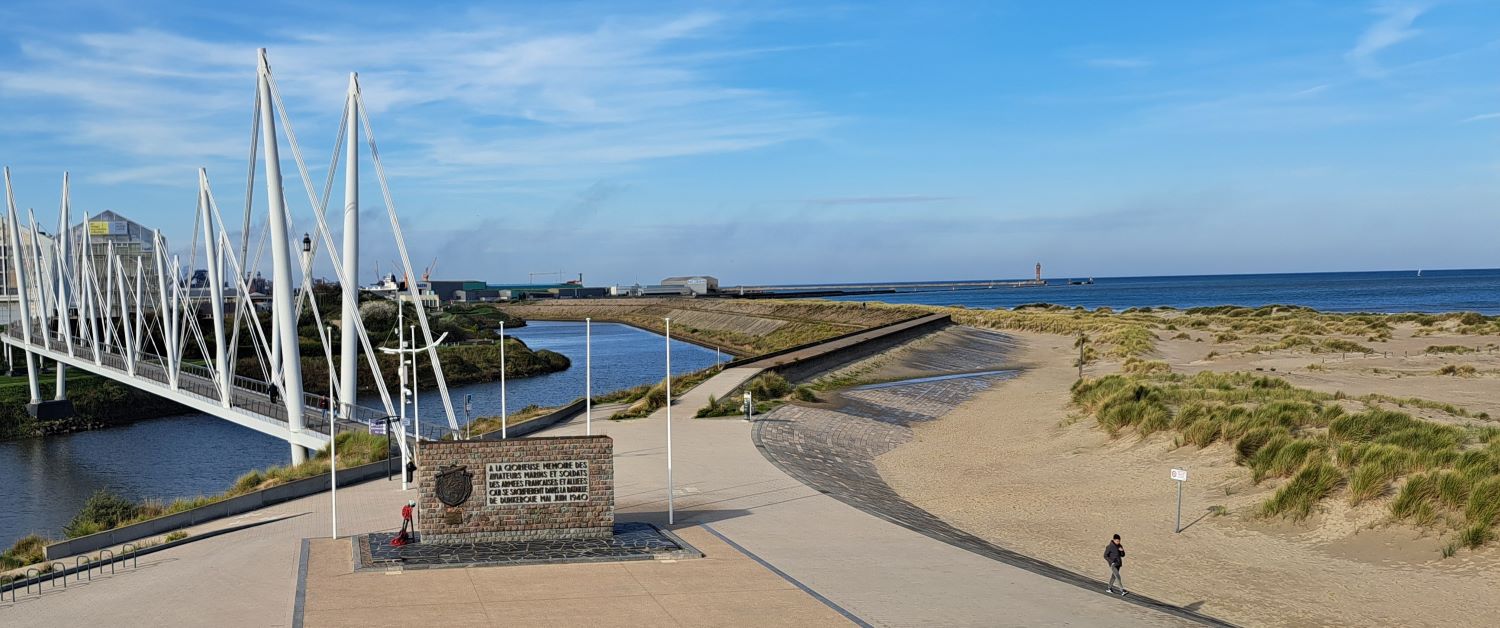
View to the war monument and evacuation pier from the start of the digue and the beach in Malo-les-Bains, Dunkirk. Photo GLK.
As a child during the Second World War, Alice Evleth read Paul Gallico’s The Snow Goose, a fantasy account of the evacuation of Dunkirk in 1940. Rereading the novella this summer, she had a sudden urge, a need even, to visit Dunkirk for the first time, though she’s lived in Paris for over 50 years. That visit in September resulted in her memoir vignette titled The Snow Goose Returns to Dunkirk, published in the Impressions section of France Revisited.
Alice’s vignette in turn inspired me to visit Dunkirk for the first time, though I’ve lived in Paris for over 35 years. My goal was above all pragmatic since I sought to complement The Snow Goose Returns to Dunkirk with practical information for those interested in visiting Dunkirk to learn more about the wartime evacuation on site. Anyway, I’m always up for an excursion of discovery—all the better when planned just several days in advance with an eye to the weather report: a mild, mostly sunny October weekday.
Americans don’t generally venture much north of the Paris region. Hauts-de-France (Upper France), the region that tends toward the Belgian border, is typically off radar unless one’s heading south by car from Belgium. British travelers naturally have more of a historical connection to Dunkirk and closer proximity. Dover is 50 miles away by sea, and there remains the national memory of the important and terrible events of the spring of 1940, when, as France was falling to Germany, 338,000 soldiers were successfully evacuated from Dunkirk Harbor and the nearby beaches. From May 26th to June 4th 1940, as the German jaw closed in, 198,000 British and 140,000 Allied soldiers, mostly French, were evacuated to England. They managed to escape on British cruisers and destroyers and other military craft for the most part as well as from hundreds of “little ships.” Some 12,000 soldiers died during the evacuation, including 5000 at sea.
Dunkirk (Dunkerque in French) is just 8 miles from the Belgium border. It’s a 30-35-minute train ride from Lille and less than an hour by car from Bruges (Belgium). It’s also easy enough to set out from Paris, as I did, 2-2½ hours by train.
The video below presents a summary of my day trip to Dunkirk. Leaving early from Paris and returning late, I had adequate time to see what I’d come to see, yet other approaches are certainly possible, and an overnight would loosen the timetable.
Three zones of highlights
If willing to walk four or five miles over the course of the day, Dunkirk can be considered walkable. Meanwhile, city buses are free and so can serve as hop-on-hop-off transportation along the way. It’s also possible to rent a bike for the day and include in plans a 30-minute ride along cycling paths to the Belgian border then back.
Generally speaking, there are three major zones to explore during a short visit.
1. The town center: Belfries, Saint Eloi Church and Jean Bart
About 85 percent of Dunkirk was destroyed during the war, yet several important historical remnants can still be seen. It’s a 15-minute walk from the train station to the 15th-century Saint Eloi Belfry that can be climbed for a panoramic view over this town of just over 80,000 inhabitants. That’s a good place to start since the Dunkirk Tourist Office is on the ground floor. Though an elevator leads partway up the 190-foot belfry, you have to earn the view by then ducking your head to take the 65 steep, narrow steps to the top for the panoramic view. The chimes still sound in the belfry, and some of the 50 bells that comprise the carillon can be seen as you climb.
The belfry was once attached to Church Saint Eloi, but a French invasion of this border territory in 1558 damaged the church. Rebuilt, but never completed according to its original plans, the late Gothic church is now separated by a street from the belfry.
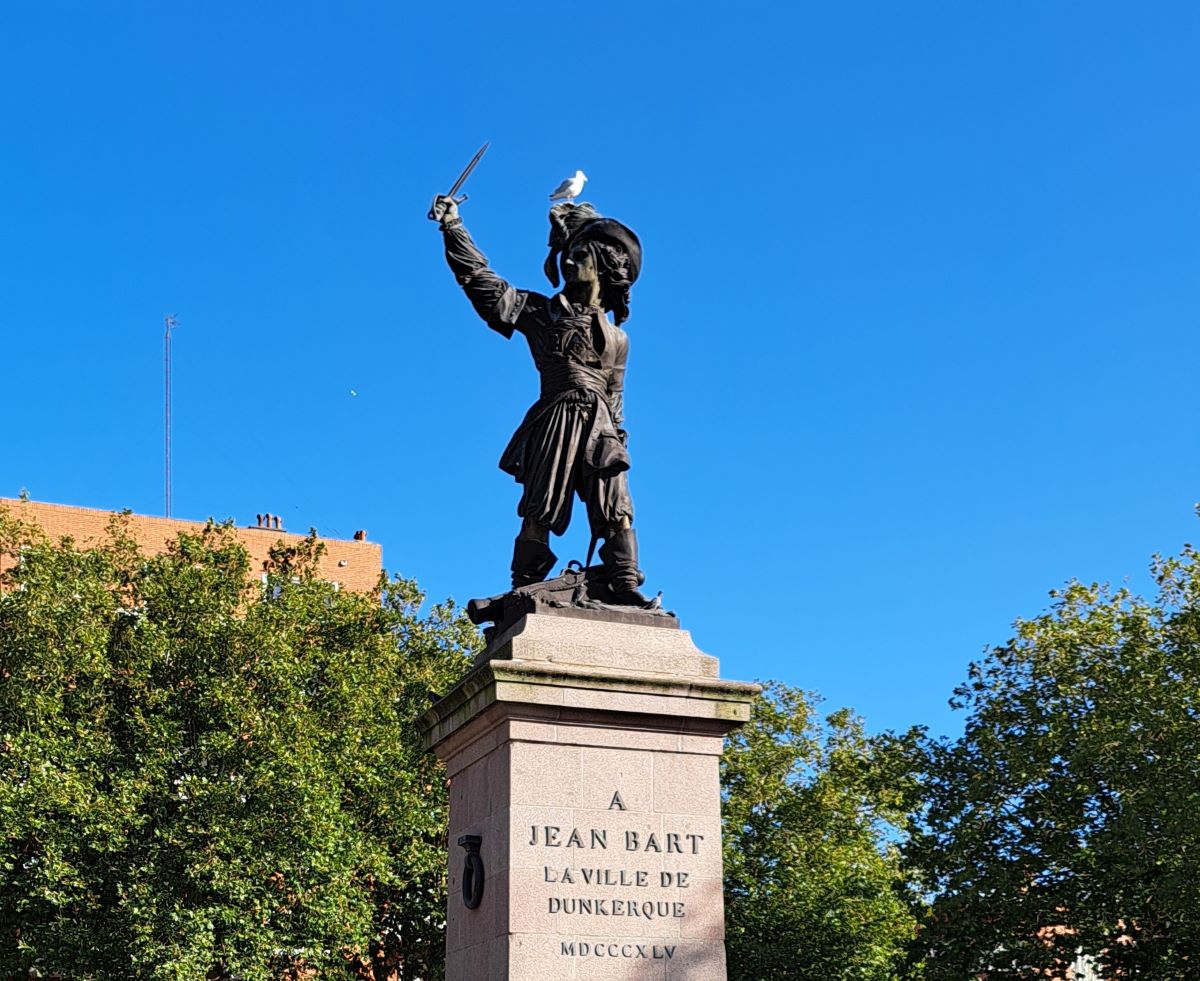
In its choir, by the altar, lies the tomb of Jean Bart (1650-1702), the town’s favorite son and one of France’s most famous privateers thanks to his swashbuckling service to the kingdom during Louis XIV’s numerous mid-reign wars. Among other heroics that contributed to Bart’s renown were his actions in keeping 120 boatloads of food supplies imported from Norway from falling into the hands of the Dutch, France’s then-enemy, at a time when France was in danger of falling into famine. That a swashbuckler should eventually earn the honor of such a distinguished place of burial is a clear sign of his reputation. Bart’s tomb is often covered by a rug but his tombstone is visible to the left of the choir. A statue (1845) of Jean Bart by David d’Angers, a major sculptor of the era, stands on the large square nearby.
The statue’s left cheek bears the wound of wartime gunshot from 1945. The edge of the sword was dented by shrapnel in 1940. An outline of Bart’s exploits can be read here, in French.
Several blocks away, on the way to the Dunkirk 1940 Museum and the beach district Malo-les-Bains, Dunkirk City Hall also sports an impressive belfry, a common feature of city halls in northern France.
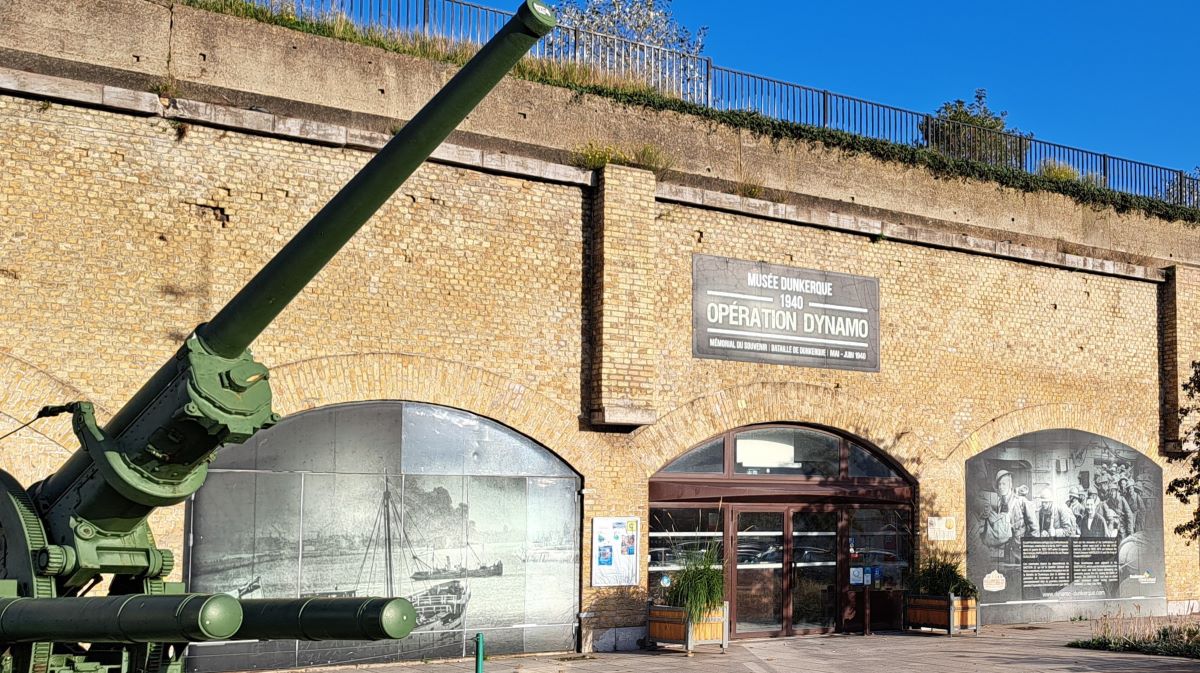
2. The Dunkirk 1940 – Operation Dynamo Museum
Open daily, the museum is a 20-minute walk, just under one mile, from the belfry. (Again, there are free buses throughout the town.)
During my short visit, Emmanuel Clermont, a guide with the tourist office, provided excellent guidance throughout the afternoon, as well as pleasing company. Arranging in advance at the tourist office for Emmanuel or another available guide for several hours or for the day would certainly allow for an edifying visit. With or without a guide, the informative and clearly presented now old-fashion Dunkirk 1940 Museum is the place to start learning on site about the town’s war history. It’s located within the curtain walls of a bastion dating from 1874 that served as headquarters for the defense of Dunkirk during the evacuation. The presentation begins with the 12-minute video that explains how Dunkirk came to be the evacuation point following the German blitzkrieg of the spring of 1940 and about Operation Dynamo, the wartime code for the evacuation itself. The museum then presents the timeline of the battle through models of the beaches and harbor, uniforms, weaponry and vehicles, and also tells of Dunkirk through the war.

3. Malo-les-Bains: La digue, historic villas and the beach
Beyond the old bastion and the harbor, the resort area of Malo-les-Bains, where soldiers were able to board the smaller craft during the evacuation, was distinct from Dunkirk until the two merged in 1970. It was and remains a well-known seaside destination for the inhabitants of Lille and the department of Nord (North) in which Dunkirk located.
A 10-minute walk from the museum, at the western end of Malo and the start of the digue, as the seaside embankment and promenade is called, there stands a block-like monument that pays tribute “to the glorious memory of the airmen, sailors and soldiers of the French and allied armies who gave their lives in the Battle of Dunkirk May June 1940.” Oddly to me, accustomed as I am to seeing bilingual war memorials in the Normandy Landing Zone, the wording on this monument is only in French, though there are British poppy wreaths attached to an anchor on the side. It appears that the British and the French see the evacuation of Dunkirk from different angles. Initially, Churchill ordered only the evacuation of British soldier before beginning the transportation of French as well, leading to German and Vichy French propaganda that the Britain had abandoned its allies. From the monument, it’s possible to walk out to the start of the pier from which so many soldier were evacuated. (I leave it to readers to delve deeper into the subject of Operation Dynamo on site or from home.)
The sea was relatively calm and the sky clear during much of the evacuation of the spring 1940, which contributed to its success. Similar conditions accompanied my October excursion. Be forewarned, however, that the coastline of northern France is known to have weather that can go through four seasons in a single day.
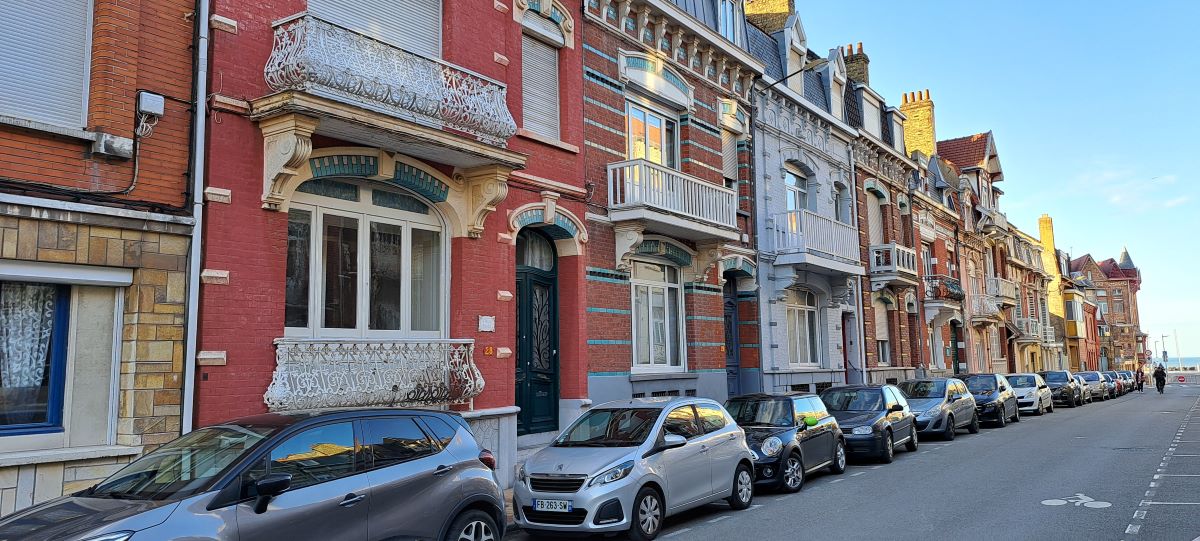
While a visit to Malo invariable involves a stroll along the digue, also have a meander a block or two inland to see some of the restored or copied early 20th-century villas. Malo’s wartime destruction at 65% means that it was slightly less damaged than Dunkirk and its harbor.
About three-quarters of a mile along the digue from the monument, you’ll come upon a cluster of local hotspots for coffee, a drink or a meal: Le Tchin-Tchin, Le Red Rock Café and Le Cactuscafé.
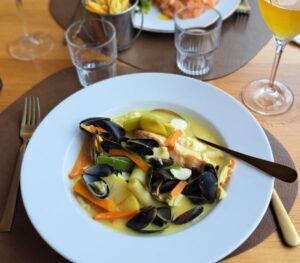
Beer is the alcoholic beverage of choice in Upper France thanks to its numerous breweries. (What few vineyards exist in the region, in its southernmost tip, nevertheless come with high pedigree as they lie within the champagne grape-growing area.) One of the breweries (brasseries) of Upper France with the best reputation is Brasseries du Pays Flamand in Blaringhem. Their Anosteké was named world’s best pale beer at the World Beer Awards in London in 2021. Their Bracine was named world’s best triple in 2023.
Having mentioned regional beer, I ought to mention a regional dish that can go with it: waterzooi, a creamy Flemish fish stew that’s served in Belgium and in this border region of France. It’s what I enjoyed for lunch, after a dozen escargot-style mussels. I ate not along the digue, but at the stew’s namesake restaurant Aux Wrterzooi, 82 quai des Hollandais, located between City Hall and the Dunkirk 1940 Museum.
Celebrations
During the chill of winter, Dunkirk keeps warm on weekends by organizing shoulder-to-shoulder festivities throughout the Carnival season, culminating in Mardi Gras week celebrations that include the annual herring throw (yes, herring is thrown down onto an impatient, costumed crowd from the balcony at City Hall) and weekend balls. See here for more details.
Each year, Dunkirk also commemorates the events of the 1940 evacuation, highlighted by more extensive commemorations every five years. In May 2025, Dunkirk will celebrate the 85th anniversary with a major gathering of the surviving (and much restored) little ships that took part in Operation Dynamo. One of those ships—not so little after all—is docked year-round in Dunkirk. It’s the Princess Elizabeth, a British paddle steamer that made four crossing to evacuate British and French soldier in 1940. Built in 1926 and named after the infant princess who would become queen, it is docked in the port area near the Mercure hotel (see below), a 10-minute walk from the train station. It’s now a restaurant, tea room and bar.
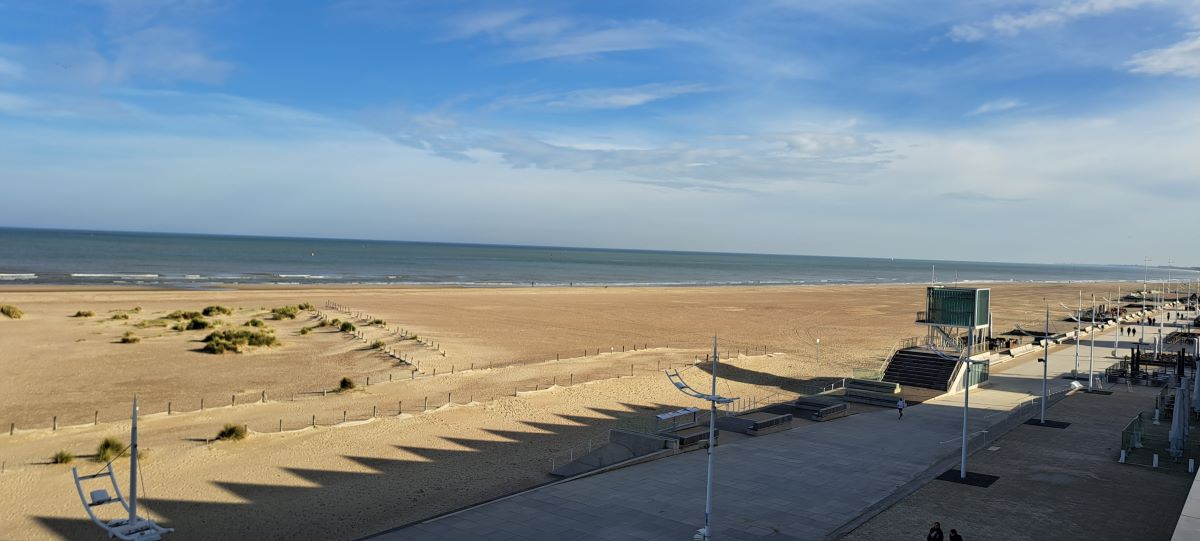
Three 4-star hotels in Dunkirk
The overnight visitor arriving by train might stay either by the station (e.g. at the Mercure) or in Malo (e.g. the Radisson Blue or the Merveilleux). If arriving by car, staying in Malo would be the more attractive choice, though there’s parking by the Mercure as well. Or perhaps you plan to bike through Dunkirk at the start or finish of the Vélo Martime cycling route that extends over 900 miles from the Belgian border to Roscoff, near the tip of Brittany. In that case, any of these hotels can provide bike parking.
Mercure Dunkerque Centre Gare, 81 rue Florence Arthaud. The Mercure (Accor) chain has an 89-room 4-star outlet, conveniently located for train travelers just 500 yards from the station and by the pleasure port. There are port views from some of its family and “premium” rooms, all of decent size. From here it’s a 10-minute walk to the belfry and surroundings at the center of town. Parking across the street. The above-mentioned Princess Elizabeth is close by.
Radisson Blu Grand Hotel & Spa, 4-8 rue Marcel Sailly. Like the Mercure but with more amenities, this is a well-situated recent 4-star hotel (2022) from a major chain. The majority of its 110 rooms are 23m2 (230 sq. ft.), meaning sufficiently large by French standards. Many have sea views (the image above and the one the top of this article were taken from the hotel) with balcony or terrace, including family rooms. The hotel is situated at the start of the western end of the beach of Malo, a 10-minute walk from the Dunkirk 1940 Museum. The hotel’s indoor swimming pool is free to guest 7-10am and 8-10pm, otherwise it’s part of the paid spa area. The hotel has some private parking spaces.
Le Merveilleux Malo, 77 Digue de Mer. About three-quarters of a mile further along the digue (the seaside promenade), this is a 20-room 4-star family-run hotel with cozy smaller rooms, sea views from the front, and seaside eating and drinking establishments right nearby. Some private parking spaces. The same family owns Aux Waterzooi, where I had lunch.
See the official site of the Dunkirk Tourist Office for further information about the town and its surroundings, including other sights and museums related to the area’s military and maritime histories.
© 2024, Gary Lee Kraut


Poignant, insightful, lovely despite the reference to so much sorrow that brought it fame.
Informative and engaging. Keep it up!